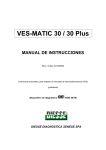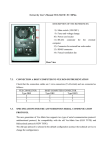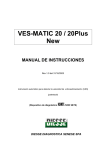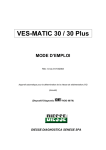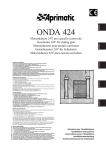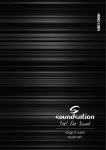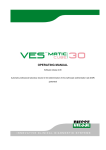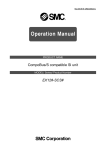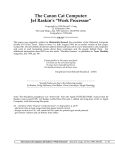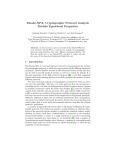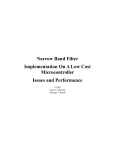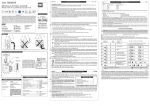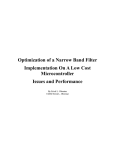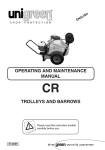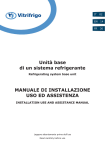Download VES-MATIC 20 VES-MATIC 20 PLUS Service Manual
Transcript
DIESSE DIAGNOSTICA SENESE S.P.A. VES-MATIC 20 VES-MATIC 20 PLUS Service Manual Release 1.00 - English Automatic instrument for the determination of the erythrosedimentation rate (ESR) (patent pending) The information contained in this manual can be subject to modification without notice. Any of the parts of this manual can be reproduced in any way or media electronic or mechanical, for any use, without the written authorisation of Diesse Diagnostica Senese S.p.a. Copyright © October 2001. Diesse Diagnostica Senese S.p.a. All rights reserved. 2 TABLE OF CONTENTS 1. VES MATIC 20 / VES MATIC 20 PLUS INTERVENTION PROCEDURES (TROUBLE SHOOTING) ............................................p.5 1.1. 1.2. 1.2.1. 1.2.2. 1.2.3. 1.2.4. 1.2.5. Approach to the VES MATIC 20 / VES MATIC 20 PLUS instrument Analysis of the faults The instrument does not switch on The instrument switches on / Self test The instrument switches on / Display The instrument switches on / Printer The instrument switches on / Check Device 2. PROCEDURE TO DISMOUNT THE ROTATION MOTOR GROUP - SAMPLE HOLDER PLATE.................................p.11 3. PROCEDURE TO REASSEMBLE THE ROTATION MOTOR GROUP - SAMPLE HOLDER PLATE.................................p.12 4. PROCEDURE TO CALIBRATE THE VES MATIC 20 / 20 PLUS INSTRUMENT FOLLOWING DISMOUNTING OR FOLLOWING A PERIODICAL CHECK-UP ......p.13 5. PROCEDURES TO FOLLOW FOR INTERVENTIONS ON THE DIFFERENT MODULES ................................................................................................................................p.19 5.1. 5.1.1. 5.1.1.1. 5.1.1.2. 5.1.2. 5.1.3. 5.1.4. 5.1.4.1. 5.1.5. 5.1.6. SERVICE MANUAL THE POWER SUPPLY MODULE...................................................p.19 General Aim Applicability Relative documentation Relative instrumentation Trouble shooting Description of the module Flow Chart no. 2 Access to the module Appendix A: Examination of the faults 5.2. 5.2.1. 5.2.1.1. 5.2.1.2. 5.2.2. 5.2.3. 5.2.4. 5.2.4.1. 5.2.5. 5.2.6. SERVICE MANUAL CPU MODULE ...................................................................................p.33 General Aim Applicability Relative documentation Relative instrumentation Trouble shooting Description of the module Flow Chart no. 3 Access to the module Appendix B: Examination of the faults 3 5.3. 5.3.1. 5.3.1.1. 5.3.1.2. 5.3.2. 5.3.3. 5.3.4. 5.3.4.1. 5.3.5. 5.3.6. SERVICE MANUAL DISPLAY/KEYBOARD MODULE ..................................................p.47 General Aim Applicability Relative documentation Relative instrumentation Trouble shooting Description of the module Flow Chart no. 4 Access to the module Appendix C: Examination of the faults. 5.4. 5.4.1. 5.4.1.1. 5.4.1.2. 5.4.2. 5.4.3. 5.4.4. 5.4.4.1. 5.4.5. 5.4.6. SERVICE MANUAL PRINTER INTERFACE MODULE .................................................p.59 General Aim Applicability Relative documentation Relative instrumentation Trouble shooting Description of the module Flow Chart no. 5 Access to the module Appendix D: Examination of the faults. 5.5. 5.5.1. 5.5.1.1. 5.5.1.2. 5.5.2. 5.5.3. 5.5.4. 5.5.4.1. 5.5.5 5.5.6. SERVICE MANUAL MOTORS AND CONTROLS BOARD MODULE .........................p.73 General Aim Applicability Relative documentation Relative instrumentation Trouble shooting Description of the module Flow Chart no. 6 Access to the module Appendix E: Examination of the faults. Appendix F: CONNECTION TO A HOST COMPUTER AND SPECIFICATIONS OF THE COMMUNICATIONS PROTOCOL FOR VES-MATIC 20 / VES MATIC 20 PLUS Appendix G: CONNECTION OF A BARCODE READER TO INSTRUMENTS OF THE VES LINE Appendix H: FIRMWARE UPGRADE FOR THE VES MATIC 20 AND VES MATIC 20 PLUS INSTRUMENT Appendix I: LAYOUT FOR ELECTRONIC CONTROL BOARD AND SCHEMATICS 4 1. VES MATIC 20 / VES MATIC 20 PLUS - INTERVENTION PROCEDURES (TROUBLE SHOOTING) Before performing any type of intervention on the instrument: a) SWITCH OFF THE ON/OFF SWITCH ON THE VES MATIC INSTRUMENT. b) DISCONNECT THE INSTRUMENT FROM THE POWER SUPPLY IN ORDER TO AVOID ANY RISK OF CONTACT WITH ELECTRICAL OR MECHANICAL PARTS UNDER LINE VOLTAGE. IF THESE BASIC RULES ARE NOT FOLLOWED, THE MANUFACTURER OF THE VES MATIC 20 / VES MATIC 20 PLUS INSTRUMENT WILL ACCEPT NO FURTHER RESPONSABILITY. 1.1. APPROACH TO THE VES MATIC 20 / VES MATIC 20 PLUS INSTRUMENT 1. Observe the recommendations reported in paragraph 1. 2. Open the outer covering of the instrument. 3. Gain access to the module of interest, as described in the procedures reported hereafter (see Flow Chart no. 1). VES MATIC 20 VES MATIC 20 PLUS Type of Fault Analisys of fault OK N S Dissasembly of the module (Dismounting Procedures) Intervention on the Module of Interest (Trouble Shooting) Reassembly of the Module of Interest (Reassembly Procedures) Retesting of the Module of Interest (Calibration Procedures) Flow-chart n°1 5 1.2. ANALYSIS OF THE FAULTS The faults reported in the following paragraphs make reference to the Trouble Shooting procedures described for the individual modules, in order to demonstrate the type of approach to follow in these situations. 1.2.1. The instrument does not switch on a) Check that the mains power supply is working. b) Check the power cable. c) Check the fuses at the back of the instrument. d) Check the ON/OFF switch on the back of the instrument. e) Check the Power supply module (see procedure regarding Power supply). 1.2.2. The instrument switches on / Self Test The instrument is switched on but the Self-Test is performed incorrectly, gives Error codes, or is not performed at all. a) The Self-Test is not performed Check that the cover is closed - Close the cover. Check the I/O board (see 5.5. procedure). Check the CPU board (see CPU procedure). b) The Self-Test is performed incorrectly - Error codes are visualized. During the Self-Test the following Error Messages may appear on the display: 1) Error reading Error in reading of the Motor Error in reading of the Home sensor (see 5.5. procedure) Check the Home Sensor (see 5.5. procedure). Check the Motors and Controls Board (see 5.5. procedure). 2) Error plate The sample plate holder does not move up and down Check the UP/DOWN Sensor controlling the plate position (see 5.5. procedure) Check the cabled Motor-reducer (see 5.5. procedure) Check the Motors and Controls Board (see 5.5. procedure) 3) Error Mixing The Sample holder plate does not rotate Check the Plate Motor (see 5.5. procedure) Check the Plate Home Sensor (see 5.5. procedure) Check the Home sensor stirrup (see 5.5. procedure) Check the Motors and Controls Board (see 5.5. procedure) 4) Check Device exhausted The Check Device is not working Check the Check Device (see 5.5. procedure) Check the Motors and Controls Board (see 5.5. procedure) 6 1.2.3. The unit is on/display a) The display visualizes but does not illuminate (backlighting ) b) The display does not visualize but illuminate c) The display does not visualize and does not illuminate d) The display visualize but the data can not be entered with the keyboard See Display/Keyboard module procedure (5.3.). 1.2.4. The instrument switches on / Printer a) The paper is not fed in; the printer does not print. b) The paper advances but the printer does not print. c) The printer prints but the paper does not advance correctly. d) The printer prints in the compressed form. e) The printer prints the wrong characters (see Printer procedure 5.4). 1.2.5. The instrument switches on / Check Device a) The Check Device does not charge Check that the Check Device is inserted correctly: - Switch off the instrument - Insert a new Check Device in the Check Device holder with the label facing the operator (see operator manual, Check device procedure) - Switch on the instrument. If all is KO, check the Motors end Controls Board (see 5.5. procedure). 7 EXPLODED VIEW AND PART LIST TABLE 8 161 033 046 034 084 035 159 044 043 158 045 095 160 081 157 066 083 042 156 036 041 040 064 037 037 095 065 149 150 085 082 154 149 153 151 095 152 039 155 038 Esploso M eccanica VES-M ATIC 20 N ew - Pag.1/4 10 109 008 056 090 107 203 091 108 075 202 007 105 001 072 074 002 053 073 092 052 099 051 093 106 092 054 096 097 006 055 047 104 093 094 049 094 050 048 104 005 103 099 102 137 101 100 003 Esploso M eccanica VES-M ATIC 20 N ew - Pag.2/4 11 12 098 020 122 061 123 098 132 095 078 060 125 146 147 004 017 016 077 019 018 062 060 124 126 060 148 131 129 130 141 128 127 145 021 136 022 138 063 023 079 031 024 032 025 026 144 030 095 080 139 027 029 143 139 140 141 142 028 095 062 Esploso M eccanica VES-M ATIC 20 N ew - Pag.3/4 135 137 139 13 110 011 Esploso M eccanica VES-M ATIC 20 N ew - Pag.4/4 095 010 009 076 012 114 011 086 112 111 113 015 111 112 115 121 116 120 014 117 059 118 119 059 14 208 206 200 217 201 219 204 205 212 218 207 211 203 9 2 C ES IN T 6 PR 5 1 FE ED 0 ST D IS P C LO TE 7C 3 K ME OK 8 4 NU 209 213 214 215 202 210 216 30002870 – Ves-Matic 20 New 30002570 – Ves-Matic 20 Identisystem 30002830 – Ves-Matic 20 Plus Part list Position Code Description Note 001 002 003 004 005 006 007 008 009 010 011 012 013 014 015 016 017 018 019 020 021 022 023 024 025 026 027 028 029 030 031 032 033 034 035 036 10325860 10128470 10301290 10126400 10327500 10325871 10327880 10323970 11504520 10325530 10325521 10118881 30401950 10330790 10330790 30204440 10325581 10127530 10125590 10327540 10325551 10327850 10119081 30204660 10125610 10118941 10118951 10325571 30401731 30204650 30204680 10325630 10601340 10127240 10328100 10802110 Case power supply Insulator pad for power supply Ves20 painted tray V20 pivot plate Ves20 new base plate Support for power supply Carter riser in/out Card support oxy/opto Spheric bearing SKF GE 8 C Upsetting pivot bush Ves20 fixed stirrup Square photocell activation Motorid. TRIAL mod. Mechanical axis support Mechanical axis support Ves20 complete plate Rotation pivot plate V20 friction plate Reset plate photocell support Cover drive card Moving mechanic support Support guide reading Group guide reading Group slide reading Read_home square Square fixing belt Plate belt clamp Motor reading supprt Tractor pulley undercarriage resding Pulley group Group support reading guide Reading sensor fixing plate Ves20 plastic bubble Bubble’s zipper V20 Bubble’s strapV20 Ves20 adhesive product 15 Position Code Description Note 037 038 039 040 10127270 10325840 10127910 1110F35Z 041 042 043 044 045 046 047 048 049 050 051 052 053 054 055 056 057 058 059 060 061 062 063 064 065 066 067 068 069 070 071 072 073 074 075 076 077 10301330 10328090 10126750 30204720 10127260 10301280 10325850 30112281 1110030Z 1110F56Z 11141172 30112050 30114070 30114100 10328490 30113480 V20 bubble zipper guide Half-case/microswitch support V20 glass display Würth 0683-284-3 (single) self-adhesive buffer Ves20 painted up case V20 painted box printer Paperbreaking Assembly fulcrum zipper printer cover Printer cover zipper V20 painetd printer cover CPU protection case CPU board Ves30/Ves20 Rev.01 Hexagonal spacer STEAB 5021/3////06 spacer Screw M3x6 UNI 7687 inox Cabled bar-code reader Fun cooler V30/V20 new Flash board writer rev.01vers.V30&V20new Flash writer fixing plate Signals board IN/OUT RS485/prog 30114060 30111640 30111650 30114050 30112310 30113470 30113750 30111340 Motoreducer. cabl.traslation V30/V20 new Ves 20 Cabled photocell board Motors diver board Cabled Reading motor./agitat. V30/V20 new Reading sensor board Ves20 keyboard Interf. board display+keyb. Ves20 Small printer board. WT01 21440230 21200540 20892130 1110010Z 1110584R 1110008Z Supply. Mean-Well PT65-D (+5/+12/+24) Black bip.int OMEGA I4700 16A/250V Mains input plug ACTRONIC AR-09-2F-6A STEAB 5021/5////05 spacer Seeger ring E 8 UNI 7435 ELESA B193/15P-M4x10 knob 16 Position Code Description Note 078 079 080 081 082 083 084 085 086 … … 089 090 091 092 093 094 095 096 097 098 099 100 101 102 103 104 105 106 107 108 109 110 111 112 113 114 115 116 117 118 1110010Z 1110675Z 11712010 12500290 21200680 21430120 12300010 10326070 10125620 STEAB 5021/5////05 spacer Benzing ring 6 UNI 7434-75 1056 MXL 025 (svil. 268,386) belt Zipper art. 101 30x30 nikel. Microswitch Honeywell V5C010BG1L 11141394 1110023Z 1110024Z 1114473L 11141394 1114544Z 1114499Z 1110H65Z 1110F30Z 11141182 11160971 11141934 1114B39Z 1114505Z 1114B62Z 1114474L 11141183 11141183 20814070 11141272 11141182 11141172 1114476L 1114549Z 11141394 11141183 11141424 11141383 11141376 1114501Z Screw M4x10 UNI 5931 inox Hexagonal spacer F-F M3x30 Hexagonal spacer M-F M3x20 Nut M3 UNI 5588 inox Screw M4x10 UNI 5931 inox Rosetta 4x12 inox Rosetta 3,2x7 UNI 6592 inox PrinterPANAS.EPL-1902S2AE(PAN-MEC000200) Termal printer roll l=58 mm Plate microswitch Bush of beat DIST.ESAG. F-F M2 E.ZUB. FF10 H 2040 12 Hexagonal spacer M-F M3x12 Screw M3x8 UNI 7687 inox Screw M2x5 UNI 6109 Ot Screw M6x10 UNI 5931 inox Rosetta A6,4 UNI 1751 grover inox Rosetta 6,4x12,5 UNI 6592 inox Rosetta dentellata A4,3 DIN 6798 inox Nut M4 UNI 5588 inox Screw M3x8 UNI 7688 inox Screw M3x8 UNI 7688 inox Kit col.fiss.conn.vasch. M/F nikel L=7 Screw M3x30 UNI 7687 inox Screw M3x8 UNI 7687 inox Screw M3x6 UNI 7687 inox Nut M6 UNI 5588 inox Washer 6x18 inox Screw M4x10 UNI 5931 inox Screw M3x8 UNI 7688 inox Screw M4x16 UNI 5931 inox Screw M4x8 UNI 7688 inox Screw M4x6 UNI 5923 inox Washer 4,3x9 UNI 6592 inox 17 Position Code Description Note 119 120 121 122 123 124 125 126 127 128 129 130 131 132 133 134 135 136 137 138 139 140 141 142 143 144 145 146 147 148 149 150 151 152 153 154 155 156 157 158 159 11141394 1114474L 1114501Z 1110026Z 1110027Z 11141404 11141192 1110021Z 11141402 1114B37Z 1114501Z 11141174 1114501Z 1110389G Screw M4x10 UNI 5931 inox Nut M4 UNI 5588 inox Washer 4,3x9 UNI 6592 inox Hexagonal spacer M-F M3x30 Hexagonal spacer M-F M3x10 Screw M4x12 UNI 5931 inox Screw M3x10 UNI 7687 inox Hexagonal spacer M-F M3x15 Screw M4x12 UNI 7687 inox Washer A4,3 UNI 1751 grover inox Washer 4,3x9 UNI 6592 inox Screw M3x6 UNI 5931 inox Washer 4,3x9 UNI 6592 inox Screw PZAB 2,9x6,5 UNI 6954 Zn 11141402 1114501Z 11141173 11141173 11141174 1114501Z 1114B37Z 11141394 11141176 11141092 11141484 1110460Z 11141242 11141376 1110459Z 11141242 11141192 11141224 1110389G 1110F42Z 1110009Z 11141182 1110391H 1110383G 1110381G Screw M4x12 UNI 7687 inox Washer 4,3x9 UNI 6592 inox Screw M3x6 UNI 7688 inox Screw M3x6 UNI 7688 inox Screw M3x6 UNI 5931 inox Washer 4,3x9 UNI 6592 inox Washer A4,3 UNI 1751 grover inox Screw M4x10 UNI 5931 inox Screw M3x6 UNI 5923 inox Screw M2,5x6 UNI 7687 inox Screw M4x30 UNI 5931 inox Nut autoblocking M4 UNI 7473 Zn Screw M3x20 UNI 7687 inox Screw M4x6 UNI 5923 inox Nut autoblocking M3 UNI 7473 Zn Screw M3x20 UNI 7687 inox Screw M3x10 UNI 7687 inox Screw M3x16 UNI 5931 inox Screw PZAB 2,9x6,5 UNI 6954 Zn Hexagonal spacer M-F M4x15 Washer STEAB 5015/4/1//16 Screw M3x8 UNI 7687 inox Screw PZAB 2,9x13 UNI 6955 Zn Screw PZAB 2,2x6,5 UNI 6954 Zn Screw PZAB 2x5 UNI 6954 Zn 18 Position Code Description Note 160 161 162 163 164 165 166 167 168 169 170 … … … 11141172 11141183 Screw M3x6 UNI 7687 inox Screw M3x8 UNI 7688 inox -------------------- Cables list--------------------------------Position Code Description Note 200 201 202 203 204 205 206 207 30113870 30114280 30114270 30114260 30114250 30114240 30114300 30114080 Signals motors driver cable V30/V20 new Flash writer cable Ves20 Seriale cable RS232C V20 Barcode reading cable ext. V20 Seriale connection cable RS485 V20 Internal programm. Cable ISP V20 Ground cable L=400 O/O External programming cable V30&V20 e Optional 208 209 30113840 30114000 210 211 212 30113990 30114290 30113890 213 214 215 216 217 218 30114020 30114010 30114190 30114230 30113930 30113940 219 30113980 Printer cable V30/V20 new Power supply cable 90/264Vac Ves30/Ves20 new Power supply cable CPU/fan V30/V20 new Interface cable display+keyb. V20 Power supply cable motors drivers V30/V20 new Neutral cable pin/filter Ves30/Ves20 new Fase cable pin/filer Ves30/Ves20 new Ground cable L=150 O/F Ground cable L=250 O/F Microswitch cover cable Ves30 Internal cable connection bar code reader V30 new External cable connection barcode reader V30/V20 new 19 2. PROCEDURE TO DISMOUNT THE ROTATION GROUP-SAMPLE HOLDER PLATE (see figure of exploded views) Proceed step by step as reported below a) Follow the recommendations in paragraph 1 points a) and b) b) Unscrew the 5 screws (pos. 089) on the base’s external sides. c) Open the outer covering (Pos. 041), lifting the front part and rotating it towards, be carefull to don’t damage the internal cables. d) Unscrew with a key the screw (Pos. 077) that bolcks the sample holder plate ( pos. 016) e) Remove the sample holder plate (Por. 016) e) Now we have at totally disposition the instrument’s mechanics for any intervention 3.PROCEDURE FOR REASSEMBLY OF THE ROTATION GROUP-SAMPLE HOLDER PLATE Follow the procedure reported below: 3. To go backward in the procedure reported at the point N 2. 20 4. CALIBRATION PROCEDURE OF THE UNIT VES MATIC 20 /VES MATIC 20 PLUS AFTER THE DISASSEMBLY OR FOR THE PERIODICAL PROTOCOL. When the unit is assemblied back keeping the carter opened: Access to the instrument keeping pressed the button “0” of the keyboard, the instrument pages to automatically in “TEST FACTORY”. With this menù we can do test and calibration of the instrument. Test Factory On the diplay appears : VES MATIC 20 NEW TEST FACTORY and the printer makes the print below: ****************** * FACTORY TEST * ****************** - CONTROLS – (1) = SERIAL RS232 (2) = TEMPERATURE (3) = CLOCK (4) = TRANSLATOR (5) = PLATE (6) = SENSOR READING (7) = ID. SETTING (8) = CARD (9) = BARCODE (OK) = STRESS PLATE -select pressing the button “1” the voice “SERIAL RS232” Serial Protocol 1= OLD 21 2= NEW Pressing the button “1” of the keyboard we select the dates trasmission like on the old instruments Ves Matic 20/60 on the display appears: Serial Protocol OLD PROTOCOL Pressing the button “2” of the keyboard we select the new dates trasmission on the display appears: Serial Protocol NEW PROTOCOL Pressing the button “OK” we confirm the effected selection. -select pressing the button “2” the voice “TEMPERATURE” TEMPERATURE 20 In this way appears the temperature read to the instrument, if it was different as that present in the environment operate with the trimmer RV2 placed on the cpu board (Pos. 042) turning it in clockwise we growing up the temperature, in anticlockwise it reduces it. Pressing the button “OK” we come back to the menù “TEST FACTORY” and the printer prints the temperature value put: ****************** * TEMPERATURE TEST * ****************** TEMPERATURE 20 -select pressing the button “3” the voice “CLOCK TEST” DATE DD/MM/YEAR 30/10/2001 22 Pressing the button “ESC” we cancel the set up date and we place the instrument for the insertion of the new date, on the display appears: DATE DD/MM/YEAR / /20 Pressing the numerical buttons we insert the day, the month then the last two figures that indicate the year. Ex. We want to insert the date 1st Aprile 2002 Press: For the day: Button ”0” Button“1” For the month Button “0” Button “4” For the year Button “0” Button“2” pressing the button “OK” we confirm what we have pressed, automatically the instrument places itself in the menù for to put back the hour and on the display appears: TIME HH:MM:SS 09:46 :11 Pressing the button “ESC” we cancel the date fixed and we put the instrument for to insert the new date,on the display appears: TIME HH:MM:SS _ : : Pressing the numerical buuttons we insert the hours ,the minutes, then the seconds. 23 Ex. We want to insert the following time 08:50:52 Pressing: For the hours: Button”0” Button “8” For the minutes: Button “5” Button “0” For the seconds: Button“5” Button “2” Pressing the button “OK” we confirm what we have pressed, automatically the instrument updates the time , the date an the printer prints : ****************** * CLOCK TEST * ****************** DATE (dd/mm/yy) 01/04/2002 TIME (hh:mm:ss) 08:50:52 -select pressing the button “4” the voice “TRANSLATOR” on the display appears: VES MATIC 20 New TEST TRASLATOR Automatically the instrument makes the upsetting sample holder plate until the shaking position after a few seconds it gets it in the vertical . In this way we check the right working of the system and at the end the printer makes the report print: ****************** * TRANSLATOR TEST * ****************** 24 TRANSLATOR OK If there were some faultes the printer prints the following report: ****************** * TRANSLATOR TEST * ****************** TRANSLATOR KO If test “KO” verify what below: a) That there weren’t mechanic impediments for the traslation group rotation. b) That to the motor (Pos. 059) the tension arrives (we read only a medium tension because the motor is drove in PWM, about 6 Volt)use a tester for to verify. c) Verify the photocelles functionality (Pos. 060) d) If the points a, b, c are ok continue to the CPU board replace (pos. 048) look procedure chapter 5.2 . -select pressing the button “5” the voice “PLATE” on the display appears: PLATE HOME STEP: 008 The printer prints in the following report: ****************** * PLATE TEST * ****************** PLATE OK The value that appears on the display corresponds to the step number that the machine has as ofset than the home plate sensor (Pos. 060/019). The ofset means to fix the position 1 of the sample holder plate (Pos. 016) than the reading sensor. Pressing the button “5 Up arrow” we grow up the ofset of 2 steps, and pressing the button “6 Down arrow) we grow down the ofset of 2 steps. The smallest removing value of every buttons pression “5” and “6” is of two steps. Pressing the button “OK” the instrument makes a new 25 sample holder plate rotation and places itself on the new ofset set up. The display shows the new set up value. Pressing the button “ESC” we get out from the procedure and we come back to the menù “TEST FACTORY” -select pressing the button “6” the voice “SENSOR READING” on the display appears: SET SENSOR 1-AUTO ; 2-MANU Pressing the button“1” we place the sensor test in automatical way. The instrument makes a reset of the sampleholder plate placing the cuvette 1 in correspondence with the reading sensor, and asks the insertion of a new cuvette with latix calibration 3, insert the cuvette and press the button “OK” (we suggest to close the door for not have external light interferences). The instrument makes some readings until when reducing the current on the emitter sensor doesn’t pierce the latix to 3. On the display appears a trimmer calibration value (about 20). At this time the instrument asks to insert a cuvette with calibration latix 2, insert a cuvette and pressing the button “OK”. The instrument makes some readings until when regulating the current on the emitter sensor doen’t pierce the latix to 2. On the display appears for a moment the trimmer calibration value (about 40), then appears the medium value which comes calibrated the sensor, in the indicated values as the example results to be 30. Pressing the button “2” we place the manual sensor test. The instrument makes reset turn of the sample holder plate positioning the cuvette 1 in correspondence of the sensor reading, and shows the trimmer calibration value. Insert one cuvette with the latix calibration 3, press the button “TEST”, the instrument makes a reading that has to give the state sensor in light . For to found the limit point change the placed value with the button “5 UP ARROW “ for to grow up and “6 DOWN ARROW” for to grow down and press the button “TEST” to make the reading . Remove the cuvette and insert the cuvette with latix calibration 2 , pressing the button “TEST” the instrument makes a reading tha has to give for result the sensor state in dark, for to found the limit point change the placed value with the buttons “5 UP ARROW” for to grow up and “6 DOWN ARROW” for to grow down, then press the button “TEST” for to make the reading. -select pressing the button “7” the voice “ID. SETTING” on the display appears: 26 VES MATIC 20New Select ID: 01 This setting is for the connection of more instruments through the serial door RS485 (min. 1 instrument, max. 32 instruments), with the program Ves-PC for Dos as a max. 6 instruments. The default’value is 01 (low value), we can change with the buttons “5 UP ARROW” for to grow up and “6 DOWN ARROW” until the value of 32. At the end of the selection press the button “OK”the printer prints the following report: ****************** * SELECT ID * ****************** Number ID : 1 -select pressing the button “8” the voice “CARD” on the display appears: INSERT CARD……. Press a Key With this menù we can check the right work of the check device reader or of the paper that acts to check device. Insert the Check Device in the special place, with the arrow put in the direction of the instrument and the white side with Diesse green logotype in up direction. Press a button’s keyboard and on the diplay appears : RECHARGE CHECK ? 04000 Pressing the button “OK” we have the reloading of 4000 strokes of the check device, pressing the button “ESC” we get out from the menù without reloading the 4000 strokes of the check device in the instrument’s memory. If we insert a check device without strokes on the display appears: 27 CARD EXAUSTED! 00000 -select pressing the button “9” the voice “BARCODE” on the display appears: VES MATIC 20New COD: With this menù we can verify the barcode working for the instruments in version IDSYSTEM. After the selection the instrument overturns the sample holder plate in a way it can take it in the bar code reading position, pressing the button “5 UP arrow” we make turn the sample holder plate of one position in anticlockwise, pressing the button “6 DOWN arrow” we make turn the sample holder plate of one position in colckwise. After have placed a cuvette with the bar code in front of bar code press the button “3 TEST” for to turn on the reader if it comes read on the display appears in clear the barcode value. Pressing the button “ESC” we get out from the menù and we come back TEST FACTORY -select press the button “0”the voice “STRESS READING” on the display appears: VES MATIC 20New TEST FACTORY The instrument makes a reset of sample holder plate in a way to place the cuvette 1 in correspondence of the reading sensor and starts to make slide the reading sensor trolley for all the run. This test is useful in disassembly and assembly case of the reading group, in way to verify in automatic the right movement. Fot to finish the test press the button “ESC”. -select pressing the button “0” the voice “STRESS PLATE” on the display appears: VES MATIC 20New TEST FACTORY The instrument makes a reset of the sample holder plate in a way to place the cuvette 1 in correspondence of the reading sensor and starts to make wheel the sample holder plate in every 28 position, at every stop comes made a trolley reset, that brings the reading sensor. This test is useful in assembly and disassembly case of the sample holder group plate for to verify in automatically the right movement. For to finish the test press the button “ESC”. 29 5. PROCEDURES TO FOLLOW FOR INTERVENTIONS ON THE DIFFERENT MODULES 5.1. 5.1.1. 5.1.1.1. 5.1.1.2. 5.1.2. 5.1.3. 5.1.4. 5.1.4.1. 5.1.5. 5.1.6. SERVICE MANUAL THE POWER SUPPLY MODULE (Pos. 072) General Aim Applicability Relative documentation Relative instrumentation Trouble shooting Description of the module Flow Chart no. 2 Access to the module Appendix A: Examination of the faults 30 5.1. SERVICE MANUAL THE POWER SUPPLY MODULE (Pos. 072) 5.1.1. General 5.1.1.1. Aim The present document furnishes details of the Trouble Shooting procedures regarding the Power supply module (Pos. 072), assembled on the VES MATIC 20 / VES MATIC 20 PLUS instrument. 5.1.1.2. Applicability The recommendations contained in the present document are applicable for use in the final service check-up to ascertain the acceptability of the instrument. 5.1.2. Relative documentation 20102900 5.1.3. Scheme of the VES MATIC 20 / 20 PLUS system (in the current edition). Relative instrumentation Multimeter Mod. FLUKE 8010A or equivalent. Philips Laboratory Oscilloscope or equivalent. Standard laboratory welder. 3-4 mm screw-drivers, pliers, standard laboratory tools. 5.1.4. Trouble shooting 5.1.4.1. Description of the module The power supply form has made from a multifrequency multitension switching power supply that distributes the right tensions for the instrument working. The tensions accepted in entry are: Vca from 90 to 264 Volt Work frequency from 44 to 440 Hertz P Max d.c 65 Watts The tensions supplied in exit are the following: +5 Vdc n°1 red cable +12 Vdc n°1 orange cable +24 Vdc n°1 blu cable Gnd n°3 black cable 55 5.1.5. Flow Chart no. 2 Trouble shoooting phase in relation to the Power Supply module (Pos. 072). Power supply Check Power On Fuse Fuse OK ? N Change the fuse S Check the supply Cable Cable OK ? N Change the supply Cable S Change power supply Board 56 5.1.6. Access to the module a) Disconnect the VES MATIC 20 / VES MATIC 20 PLUS instrument from the power supply, as reported in paragraph 1. b) Remove the outer covering as reported in paragraph 2 in order to gain access to the internal parts. c) Unscrew the screw and remove the case (pos. 001) d) Disconnect the cable connected on Power Supply (pos. 209, 210, 216) e) Unscrew the Hexagonal spacer (pos. 090 and 091). f) Remove the Power Supply module board. g) Replace the faulty power supply board whith another new. 57 Appendix A: Examination of the possible faults The examination of the main defects is performed according to the table reported below: Type of failure The voltage is not coming through on connector pos. 209 Local effect The indicator LEDs of CPU board (pos. 048) are off. General effect No voltage is going out to the different connectors. Action 1. Ensure that the unit is correctly connected to the mains power supply. 2. Check the fuse and the cable; replace if necessary. Type of failure The LEDs of CPU board are off even though the voltage is present on cable pos. 209. Local effect The indicator LEDs are off. General effect There is no exit voltage for the power supply board pos. 072 Action 1. Ensure that the cable pos. 210 is correctly connected to the power supply and the CPU board. 2. Check if there is voltage at the exit of the power supply board, replace if necessary. 58 5.2. 5.2.1. 5.2.1.1. 5.2.1.2. 5.2.2. 5.2.3. 5.2.4. 5.2.4.1. 5.2.5. 5.2.6. SERVICE MANUAL CPU MODULE (Pos. 048) General Aim Applicability Relative documentation Relative instrumentation Trouble shooting Description of the module Flow Chart no. 3 Access to the module Appendix B: Examination of the faults 59 5.2. SERVICE MANUAL CPU MODULE (Pos. 048) 5.2.1. General 5.2.1.1. Aim The present document reports in detail the Trouble Shooting procedures regarding the CPU unit code 30100020, assembled on the VES MATIC 20 / VES MATIC 20PLUS instrument. 5.2.1.2. Applicability The recommendations reported here below are applicable in the final service check to ascertain acceptability of the product. 5.2.2. 5.2.3. Relative documentation 20102900 Scheme of the VES MATIC 20 / 20 PLUS system (current version). 20102631 Electric scheme of the CPU module. 30112281 Layout of the CPU module. Relative instrumentation Multimeter Mod. FLUKE 8010A or equivalent. Philips Laboratory Oscilloscope or equivalent. Standard laboratory welder. 3-4 mm screw-drivers, pliers, standard laboratory tools. Power Supply (Pos. 072). 5.2.4. Trouble shooting 5.2.4.1. Description of the module The CPU board controls all the peripherals connected to it. It can be subdivided into the following blocks: a) MPU & CONTROL ADDRESS/DATA BUS IC1 ATMEGA 103 b) MEMORY IC3 RAM 62256 c) DECODER IC17 EPM3064 d) SERIAL PORT /BAR CODE e) POWER SUPPLY 60 IC13, IC14, IC15 MAX 202 or equiv. CN19 MOLEX a) MPU and CONTROL ADDRESS/DATA BUS Block This block includes the microprocessor which performs the functions according to the resident programme. It contains a system clock of 6 Mhz and a bus speed (speed at which an operation is performed) of 6 Mhz. b) MEMORY Block FlashEprom This is integrated in the CPU processor which contains the control programme. The memory has a capacity of 128 KByte x 8Bit. SRam I.C. where the MPU temporarily transfers data or variables, with random access. c) DECODER Block The CPLD (Complex Programmable Logic Device) present in this block is responsible for the decoding functions. d) SERIAL PORT block & BAR CODE The serial comunication has made from the devices MAX202 or eq. where in its internal there is the necessary for to have a negative tension value and larger amplitude even if it has a feeding not larger than 5V. The dates relatives to the serial door are setting from the program so are fixed in the following: SPEED PARITA' BITS LENGHT STOP BITS 9600 BAUD (septable 19200 or 38400 bps) NOTHING 8 1 e) FEEDING block The necessary tension for the working of the board +5V and it ‘s inserted through the connector J19. 61 5.2.5. Flow Chart no. 3 Il Flow Chart n°3 mostra il diagramma di flusso per quanto riguarda la CPU pos. 048 CPU Control visualization Date on display Visualization OK? N Effect Calibration Procedure See point 4.a Control visualization Date on display Visualization OK? N Raplace CPU Function of CPU On switching on N OK? See Trouble Shooting Procedure Power Supply (Pos. 072) 62 Replace CPU 5.2.6. Access to the module a) Disconnect the VES MATIC 20 / VES MATIC 20 PLUS from the power supply, as in paragraph 1. b) Gain access to the inside of the instrument as reported in paragraph 2. c) Losen the screw pos. 051 and remove the case pos. 047 d) Disconnect the cable on CPU board pos. 048 e) Unscrew the hexagonal spacer pos. 049 f) Remove the CPU board module pos. 048 g) Replace the faulty components, as reported in Appendix B. 63 Appendix B: Examination of the possible faults An examination of the main defects is performed according to the table reported below: Type of failure The timer is not working. Local effect The clock on the display is not updated. General effect The date is not memorized in the instrument. Action 1. Replace the CPU board. Type of failure The timer is not working. Local effect The RAM works. General effect The date is not memorized in the instrument. Action 2. Replace the CPU board. Type of failure The program does not start up, or anomalies appear when switching on the instrument. Local effect The display does not visualize anything, or gives wrong information. General effect It is not possible to use the Ves Matic. There is no visualization on the display, or incorrect characters appear. Action 1. Replace the CPU board. 64 5.3. 5.3.1. 5.3.1.1. 5.3.1.2. 5.3.2. 5.3.3. 5.3.4. 5.3.4.1. 5.3.5. 5.3.6. SERVICE MANUAL DISPLAY/KEYBOARD MODULE (pos. 064/065) General Aim Applicability Relative documentation Relative instrumentation Trouble shooting Description of the module Flow Chart no. 4 Access to the module Appendix C: Examination of the faults. 65 5.3. SERVICE MANUAL DISPLAY/KEYBOARD MODULE (Pos. 064/065) 5.3.1. General 5.3.1.1. Aim The present document reports details of the Trouble Shooting procedures relating to the Display/Keyboard module pos. 064 and 065 assembled on the VES MATIC 20/VES MATIC 20 PLUS. 5.3.1.2. Applicability The recommendations contained in the present document are applicable to final servicing to ascertain the acceptability of the product. 5.3.2. 5.3.3. Relative documentation 20102900 edition). Scheme of the VES MATIC 20 / VES MATIC 20 PLUSsystem (in the current 20102850 Schema of the connection of the Display/keyboard interface Vesmatic 20 30111660 30113470 Layout of the display/keyboard module Vesmatic 20 Layout of the keyboard module Vesmatic 20. Relative instrumentation Multimeter Mod. FLUKE 8010A or equivalent. Philips Laboratory Oscilloscope or equivalent. Standard laboratory welder. 3-4 mm screw-drivers, pliers, standard laboratory tools. Power supply (Pos. 072). CPU board (Pos.048). 5.3.4. Trouble shooting 5.3.4.1. Description of the module The Display/Keyboard form pos. 064/065 has made from the display display+keyboard boards and from the keyboard . It’s interfaced from the CPU pos. 048 through the cable pos. 211, and this CPU have to be connected for to make work the form. 66 5.3.5. Flow Chart no. 4 The Flow Chart n° 4 shows the flow chart for the Trouble Shooting part’s form Display/Keyboard pos. 064/065. Diplay Check Display Connection CPU OK ? N Verify connection S Check Feeding N Feeding OK ? Verify feeding S Check Display N Display OK ? Change Display board Keyboard Check Push botton On keyboard Switching OK ? 67 N Replace Keyboard 5.3.6. Access to the module a) Turn off the feeding to the VES MATIC 20 / 20 PLUS like paragraph 1. b) Come in to the unit opening the plug like paragraph 2. c) Take off the interface cable connected on the board’s connector CN2 pos. 065. d) Unscrew the crews (pos. 154) on the board pos. 065 . e) Take off the Display/Keyboard board pos. 065, taking off the cable that connectes the board to the display (CN3). f) Change the components damaged like the Appendix C. g) If the buttons ‘s keyboard board don’t function verify the working with a setted tester, in a way to verify the continuity. 68 Appendix C: Examination of the possible faults An examination of the main defects is performed according to the table reported below: Type of failure There is no visualization. Local effect The keyboard works and voltage is present in the display; the CPU works. General effect No characters appear on the display. Action 1. Check that the display and CPU are connected to each other. 2. Replace the Display. Type of failure There is no visualization. Local effect The keyboard works and the CPU is correctly connected. General effect No characters appear on the screen. Action Check the power to the display. Type of failure There is no visualization. Local effect The keyboard works and power is present at the display; the CPU works. General effect No characters appear on the display. Action Replace the display. Type of failure Data cannot be introduced. Local effect The display and CPU are working. General effect There is no switching on the keys. Action Change the keyboard. 69 5.4. 5.4.1. 5.4.1.1. 5.4.1.2. 5.4.2. 5.4.3. 5.4.4. 5.4.4.1. 5.4.5. 5.4.6. SERVICE MANUAL PRINTER INTERFACE MODULE Pos. 066 General Aim Applicability Relative documentation Relative instrumentation Trouble shooting Description of the module Flow Chart no. 5 Access to the module Appendix D: Examination of the faults. 70 5.4. SERVICE MANUAL PRINTER INTERFACE MODULE (Pos. 066) 5.4.1. General 5.4.1.1. Aim The present document reports in detail the Trouble Shooting procedures to be used in relation to the Printer Interface Module pos. 066, assembled on the VESMATIC 20 / VES MATIC 20 PLUS. 5.4.1.2. Applicability The recommendations contained in the present document are applicable to the final servicing to ascertain acceptability of the product. 5.4.2. 5.4.3. Relative documentation 20102900 Scheme of the VES MATIC 20 / 20 PLUS system (in the current version). 20102462 Electric scheme of the Printer Interface WT01 small. 30111340 Layout of the Printer Interface Board WT01 small Relative instrumentation Multimeter Mod. FLUKE 8010A or equivalent. Philips Laboratory Oscilloscope or equivalent. Standard laboratory welder. 3-4 mm screw-drivers, pliers, standard laboratory tools. 5.4.4. Trouble shooting 5.4.4.1. Description of the module The intrerface printer module pos. 066, formed by an integrated circuit (U1) ATMEL AT908515, have to keep the printer mechanism, and the serial comunication with the instrument’s cpu. For to keep the printer mechanism we mean the paper feed, the keep of the sensorsof end paper and head up,the command of the thermic head dots. 81 5.4.5. Flow Chart no. 5 Interface module Trouble shooting. Printer Check Paper N Paper OK ? Insert Paper Y Check Paper N Paper OK ? Insert Paper correctly Y Check Power Supply on CN11 N Power OK ? Replace Power cable Replace Interface board Printer Check Head lever up N Lever OK ? Y Replace off jammed paper 82 Replace Printer Mechanism 5.4.6. Access to the module a) Disconnect from the power supply, as in paragraph 1. b) Open the outer covering (pos. 046)to gain access to the inside of the instrument and unscrew the screw pos.160, extract the printer module. c) Disconnect the power supply cable on connector CN11. d) Disconnect the serial cable connected on CN12. e) Unscrew the screw pos. 158 , remove flex cable on the printer interface board (pos. 066)connect to the connector CN3 and CN4. f) Remove the Printer Interface module from the unit by unscrewing the screws, see layout . g) Remove the cable soldering in the printer interface board, connect whith the printer mechanism. h) Substitute the faulty components, according to Appendix D. 83 Appendix D: Examination of the faults. An examination of the main defects is performed according to the table reported below: Type of failure The printer does not print. Local effect The paper does not advance forward with the printed results. General effect Printing does not take place. Action Ensure that there is paper in the printer. Type of failure The power is present, but the printer does not print. Local effect The paper does not advance forward with the printed results. General effect The printer does not print. Action Check that the paper is inserted correctly and not jammed. Type of failure The paper is present and not jammed, but the printer does not print. Local effect The paper does not advance with the printed results. General effect The printer does not print. Action Check the power on CN11. Type of failure The printer does not print. Local effect The printer print in compress mode. General effect The printer does not print correctly. Action Check the mechanical parts and paper position. Type of failure The printer does not print. Local effect The motor feed remains blocked . General effect The printer does not print. Action Check the microswitch.and head lever position. Replace the board or printer mechanism. 84 5.5. 5.5.1. 5.5.1.1. 5.5.1.2. 5.5.2. 5.5.3. 5.5.4. 5.5.4.1. 5.5.5 5.5.6. SERVICE MANUAL MOTORS AND CONTROLS BOARD pos. 061 General Aim Applicability Relative documentation Relative instrumentation Trouble shooting Description of the module Flow Chart no. 6 Access to the module Appendix E: Examination of the faults. 85 5.5 SERVICE MANUAL MOTOTRS AND CONTROLS BOARD POS. 061 5.5.1 General 5.5.1.1. Aim The present document reports in detail the Trouble Shooting procedures to be used in relation to the Motors and Controllers Board pos. 061, assembled on the VES MATIC 20 / 20 PLUS. 5.5.1.2. Applicability 5.5.2. 5.5.3. The recommendations contained in the present document are applicable to the final servicing to ascertain acceptability of the product. Relative documentation 20102900 Scheme of the VES MATIC 20 / 20 PLUS system (in the current version). 20102610 Electric scheme of the Motors and Controllers board. 30111650 Layout of the Motors and controllers board pos. 061. Relative instrumentation Multimeter Mod. FLUKE 8010A or equivalent. Philips Laboratory Oscilloscope or equivalent. Standard laboratory welder. 3-4 mm screw-drivers, pliers, standard laboratory tools. Power supply pos. 072 CPU pos. 48 5.5.4. Trouble shooting 5.5.4.1. Description of the module The Motors and Controls Board module of the VES MATIC 20 / VES MATIC 20 PLUS instrument is interfaced directly to the CPU pos. 048 from the connector CN9 and to the power via the connector CN10; the CPU must be connected in order for the module to function. This board controls the movement of the different motors actioning the sample plate, the control of the information deriving from the reading and home sensors, and of the traslator sensors position up and down. 86 5.5.5 Flow Chart no. 6 Trouble shooting phase in the Motors and Controls Board. Motors and driver Board Motors driver board Error message: ERROR READING Error message: ERROR MIXING Check Breakin belt S Replace belt Check Plate Motor N Error message: ERROR READING N Replace Motore N Replace Sensor S Error message: ERROR MIXING Check Motors Readi N Replace Motor Check Plate home sensor Error message: ERROR READING Check Home Sensor S Error message: ERROR MIXING N Replace Sensor Check plate lever Replace I/O board N Straight Lever S Error message: ERROR MIXING Check Position Sensor stirrup Home plate S Replace I/O board 87 N Put back The stirrup and The Motors driver Board Error message: ERROR PLATE Check Cabled moto N Replace Motoreduc. N Replace Sensors reductor S Error message: ERROR PLATE Check Sensor Plate Replace I/O board 5.5.6. Access to the module a) Disconnect from the power supply, as in paragraph 1. b) Open the outer covering to gain access to the inside, as in paragraph 2. c) Unscrew the screws pos. 098 and remove the case pos. 020. d) Disconnect the interface cable connected on CN9 and CN10. e) Disconnect the others connected cables. f) Replace the faulty components, according to Appendix E. 88 Appendix E: Examination of the faults. An examination of the main defects is performed according to the table reported below: Type of failure The Self-Test starts up with the error message: ERROR READING. Local effect The data is not read, or is read incorrectly. General effect Error message; the instrument does not start up. Action 1. Check that the cord is not damaged; if so, replace. 2. Check the function of the Home Sensor. 3. Check the connections to the motor. 4. Replace the I/O Board. Type of failure The Self-Test starts up with the error emssage: ERROR PLATE. Local effect The data is not read, or is read incorrectly. The plate does not rotate 90°. General effect Error message; the instrument does not start up. Action 1.Check the microswitch for the position of the plate; replace microswitch. 2.Check the connections and the state of the DC motor. 3. Replace the I/O Board. Type of failure The Self-Test starts up with the error message: ERROR MIXING. Local effect The data is not read, or is read incorrectly. The plate does not rotate on its axis, or moves in an anomalous manner. General effect Error message; the instrument does not start up. Action 1.Check the connections to the plate motor. 2.Check yhe connections and state of the Sensor Home Plate, replace if necessary. 3.Replace the I/O Board. 89 Appendix F: HOST COMPUTER CONNECTION FOR VES-MATIC LINE INSTRUMENTS AND VES-MATIC 20 / 20 PLUS COMMUNICATION PROTOCOL. Check that the connection cables are 3 wire connectors (Tx-Rx-Gnd) and are connected as follows: VES CONNECTOR Type DB9 2 3 5 HOST-COMPUTER CONNECTOR Type DB9 Type DB25 2 3 3 2 5 7 90 SPECIFICATIONS FOR THE ASYNCHRONOUS SERIAL COMMUNICATION PROTOCOL Representation of the bytes transmitted on the serial line: STX BLK BLK LEN LEN ADD ADD COM COM D1 ... Dn ETX CHK CHK Each box represents 1 byte transmitted on the serial port. The pair of bytes will instead be packed in the memory and return to the value of 1 byte. STX : Character ASCII '>' 0x3E BLK : Block Number LEN : Number of characters, from D1 to Dn (included) ADD : Device ID (00 and FF = Reserved) Available range 01-7F COM : Command ID If COM=COM+0x80, the end of the block is given by ETX and CHK is not controlled. D1.Dn : Command related data ETX : Character ASCII 'CR' 0x0D CHK : CheckSum (XOR from STX to Dn included) The reply to the protocol will have to be part of the receiving device: ACK / NAK ADD ADD ETX ACK : Character ASCII 0x06 If the command block has been correctly interpreted according to the protocol specifications NAK : Character ASCII 0x15 If the command block is not compliant with protocol specifications ADD : Device ID If data transaction requires the use of more blocks, these will be numbered in progressive order starting from 0. Every transmission of more blocks should end with a block with a length equivalent to zero. VES20/30 SERIAL COMMANDS AND PARAMETER FORMAT 91 Each command is interpreted and receives as reply ‘ACK’=[0x06]+ID+CR If a syntax error occurs or an incorrect command is issued, the reply will be ‘NACK’=[0x15]+ID+CR 0x01: Request of version Example: From Host >00000181+CR+00 Asks unit with ID ‘01‘ to run command ‘81’ (that is command ‘01’ without checksum control ) From ESR >00190101VES MATIC 20New Rel. 1.00+CR+10 0x02: Request list of stored tests The returned data field is formed by the number of tests stored in ASCII hex format (2 bytes) followed by15 byte separated by ‘;’ which specify the type, date and time of the test. Example: From Host >00000182+CR+00 Asks unit with ID ‘01‘ to run command ‘82’ (that is command ‘02’ without checksum control ) From ESR >0031010203F1 28/04 15:41;F2 28/04 15:49;F2K 28/04 16:13+CR+15 0x03: Request test transmission Example: From Host >0002018303+CR+00 Asks unit with ID ‘01‘ to run command ‘83’ (that is command ‘02’ without checksum control) with parameter ‘03’ indicating the number of tests that should be received. From ESR The reply can be formed by more blocks, depending on the quantity of information present in the test. The unit transmits a 20 byte header with information regarding - Type of test 1 byte (0x01=F1, 0x02=F2, 0x03=F1K, 0x04=F2K) 92 - ESR settings during the reception 1byte (X X BO BE BI FP FD FT where FT= temperature correction flag 1 is ON, FD=Displayed results flag, FP=Printed results flag, BI=Internal bar code selection flag, BE=External bar code selection flag, BO= Barcode deselection flag) - Number of samples 1 byte - Cycle 1byte - Temperature during test 1 byte - Test date 10 byte hex-ascii - Test time 5 byte hex-ascii Followed by a number of 40 byte fields equivalent to the "Number of samples" with the following format: - Position number 1 byte Status flag 1 byte Barcode 13 byte Hex-ascii ESR results 24 byte Katz index 1 byte Flag Status can acquire the following values: - 0 Abnormal cuvette High cuvette 0 Low cuvette x82 Empty cuvette 0 Ordinary cuvette x84 0 x88 0 x00 x81 If the test carried out is of type F1, the ESR results will be equivalent to the first byte of the 24. The Katz index shall not be taken into account. If the test carried out is of type F2, the ESR results will be equivalent to the first two bytes of the 24. The Katz index will also be taken into account If the test carried out is of type F1K, the ESR results will be equivalent to the first 12 bytes of the 24. The Katz index shall not be taken into account If the test carried out is of type F2K, the ESR results will be within the first 24 bytes. The Katz index will also be taken into account. 93 0x04: Command to request the unit status The unit status is constituted by 2 ASCII hex integers represented by means of two sets, each with 4 bytes. The first four bytes contain the following information: Bit value: Bit Code 0 1 2 3 4 5 6 Test type Test type Test type Reset in progress Check -Device expired Open cover Sample reading in progress Mixing in progress Centrifugation in progress Test aborted Error condition ------ 7 8 9 10 11 12 13 14 15 The three Type of test bits 0,1 and 2 represent: • • • • 0x01 0x02 0x03 0x04 F1 Normal F2 Normal F1 Kinetic F2 Kinetic The second group of 4 bytes represents the time in seconds needed to complete the test in progress. Example: From Host Send command >00000184+CR+00 00 Ask the unit with ID ‘01‘ to run command ‘0x84’ (that is command ‘0x04’ without checksum control) From ESR >00080104008105CD+CR+4D The status is codified as 0x0081, that is an ordinary F1 test in progress and a mixing stage in progress. The seconds needed to complete the test are 0x05CD, that is 1485 seconds. 94 0x05: Reading the Setting register The unit returns the value of the setting register in 2 ASCII hex bytes. The register bit have a Boolean value (1=ON) Bit Code 0 1 2 3 4 5 6 7 Temperature correction Displayed results Printed results Internal barcode External barcode Disabled barcode --- Example: From Host Send command >00000185+CR+00 00 Ask the unit with ID ‘01‘ to run command ‘0x85’ (that is command ‘0x05’ without check sum control) From ESR >0002010525+CR+3F Consequently: temperature correction is ON, Printed results is ON and the Barcode is disabled. 0x06: Writing in the Setting register This command enables to set the Setting register. Example: From Host >0002018682+CR+00 Ask the unit with ID ‘01‘ to run command ‘0x86’ with data field 0x82 (that is command ‘0x06’ without checksum control). This sets: Temperature correction OFF, Displayed results ON, Printed results OFF, Internal barcode ON. From ESR Replies ‘ACK’ for positive results; otherwise it replies ‘NACK' 95 0x07: Start test The command enables to start and select the type of test. The type is codified as follows: Type Code 0x01 0x02 0x03 0x04 F1 Normal F2 Normal F1 Kinetic F2 Kinetic Example: From Host Sends command >0002018703+CR+00 Ask the unit with ID ‘01‘ to run command ‘0x87’ with data field 0x03 (that is command ‘0x07’ without checksum control). This start the F1 kinetic test. From ESR Replies ‘ACK’ for positive results; otherwise it replies ‘NACK' 0x08: Block analysis The command enables to block the test in progress. Example: From Host Send command >00000188+CR+00 Ask the unit with ID ‘01‘ to run command ‘0x88’ (that is command ‘0x08’ without checksum control). From ESR Replies ‘ACK’ for positive results; otherwise it replies ‘NACK' 0x09: Read Barcode It reads the barcode stored in the requested position. Positions range from 0 to 19 for VES20. Example: From Host Send command >000201890D+CR+00 Ask the unit with ID ‘01‘ to run command ‘0x89’ (that is command ‘0x09’ without check sum control) with data field 0x0D, that is ask the barcode to be sent to position 13. From ESR >000D0109 . . . . . . . . . . . . . +6C 96 The units sends the 13 character code related to the requested barcode. 0x0A: Write barcode This command enables the write the barcode in the desired position during the test cycle. Positions range from 0 to 19 for VES20. Example: From Host Send command >000F018A07ABCDEFGHILMNO+CR+00 Ask unit with ID ‘01‘ to run command ‘0x8A’ (that is command ‘0x0A’ without checksum control) with data field 07ABCDEFGHILMNO. This enables to write the bar code “ABCDEFGHILMNO” in position 0x07. From ESR ‘ACK’ if the reply is positive; otherwise ‘NACK’ 0x0B: Read Date and Time This command enables to read the internal timer of the unit. The reply is formatted with 6 ASCII hex characters (12 byte) that refer to: hour, minutes, seconds, date, month and year. Example: From Host Send command >0000018B+CR+00 Ask unit with ID '01' to run command ‘0x8B’ (that is command ‘0x0B’ without checksum control). From ESR >000C010B0B14040C0C00+CR+4D The data field provides the following data: 11:20:04 hours with date 12/12/00 0x0C: Set date and time This command enables to set the internal timer of the unit. The command data field is formatted with 6 ASCII hex characters (12 byte) that refer to: hour, minutes, seconds, date, month and year. 97 Example: From Host Send command >000C018C0C00000F0601+CR+00 Ask unit with ID '01' to run command ‘0x8C’ (that is command ‘0x0C’ without checksum control) with data field 0C00001F0601. This enables to set the timer at 12:00:00 hours and with a 15/06/01 date . From ESR ‘ACK’ if the reply is positive; otherwise ‘NACK’ 0x0D: Read Check-Device The command returns the value of the formatted Check-Device as ASCII hex integer (4 byte). Example: From Host Send command >0000018D+CR+00 Ask unit with ID ‘01‘ to run command ‘0x8D’ (that is command ‘0x0D’ without checksum control). From ESR >0004010D0F99+CR+39 The Check-Device value is 0x0F99, that is 3993 98 CONNECTING A BAR CODE READER TO VES 20/30 INSTRUMENTATION The identification number of the samples (ID) can be entered manually or through the BAR CODE READER. 1. Before performing any connection, check that the presence of the following signals on the connector used for connection purposes (refer to the instruction manual of the bar code reader): EXTERNAL DB9 CONNECTOR SIGNAL 3 5 9 Data Rx from the scanner GND +5V 2. Connecting the barcode reader to the unit TECHNICAL INFORMATION: The connection is performed using the 9-pin DB9 connector situated on the rear of the machine. The electric levels of signals are RS232. Communications are sent only from the bar code reader to the machine. The baud rate is 9600 bit/s, the data format has 8 data bits, 1 stop bit and no parity bit. The communication protocol is ASCII, the read bar code must end with a Carriage return character (0x0d). 99 Appendix H: FIRMWARE UPGRADE FOR THE VES MATIC 30 AND VES MATIC 30 PLUS INSTRUMENT VES20NEW & VES30NEW PROGRAMMING MANUAL Ver. 1.1 - 23.07.01 PROGRAMMING SOFTWARE INSTALLATION Create the folder C:\AVRTOOLS directly on C:\ Copy the file Atmelisp.exe from floppy disk to C:\AVRTOOLS. The file Atmelisp.exe is a compressed file that when started decompress all the files it contains. To start the ‘extraction’ procedure start the program C:\AVRTOOLS\ATMELISP.EXE with double click. Click the OK button when the extracting program (UnZip) warning you that the shareware release of the program isn’t registred. Then insert ‘C:\’ in the dialog box to set the destination of the extracted files. Now all the files will be copied in the folder C:\AVRTOOLS\ATMELISP, ed it is possible to start the program ISP.EXE COPYING THE FILE TO BE TRANSFERRED TO VES20/30 Copy the file to be transferred in the memory of VES20/30 in the folder C:\AVRTOOLS\ATMELISP. The name of this file will be VES30.HEX for Vesmatic30 New and VES20.HEX for Vesmatic20 New. This contains the program of the instrument. The name of the file will remain the same for every new version of the program it contains. So if it will be necessary to upgrade the instrument with a new program release a new file called VES30.HEX or VES20.HEX will be sent to you. Then you have to overwrite the old file with the new one. PROGRAMMING THE INSTRUMENT VES20/30 Turn off the power switch and disconnect the mains cable. Take off the screws that block the panel on the top of the mains switch and extract the panel. Be careful to not disconnect the internal cables. (see the photo) Connect the Programming Cable included in the programming kit to the parallel port LPT1 of the Personal Computer. Connect the other side of the cable to the 10-ways male connector on the board fixed to the panel (see photo). 100 Connector for PROGRAMMATION Connect the 9-ways D-sub male connector (Programming Key), included in the Programming Kit, to the female connector ‘RS232’ placed near the programming panel. Insert the mains cable and turn on the Instrument. PROGRAMMING PROCEDURE Start the program ISP.EXE on the Personal Computer. Select ‘Project’ from the main menu. And then select ‘Open Project’. Browse the file VES30NEW.AVR in the folder C:\AVRTOOLS\ATMELISP and press OPEN. Then three windows will open: ‘Project Manager’, ‘Program Memory’, and ‘EEPROM Memory’. SAVING THE SETUP DATA OF THE INSTRUMENT WARNING: THE PROGRAMMING PROCEDURE WILL ERASE ALL THE MEMORY OF CPU, CAUSING THE LOST OF ALL SETUP DATA. BEFORE TO START PROGRAMMING YOU HAVE TO READ THE SETUP DATA FROM THE INSTRUMENT MEMORY AND THEN RESTORE IT AFTER THE DOWNLOAD OF THE PROGRAM. TO READ THE SETUP DATA FOLLOW THIS PROCEDURE: Select Program from the main menu, and then ’Read EEPROM’. 101 START PROGRAMMING A. Select ‘Program’, and then ‘Auto-Program Options’. Check on all the available options except ‘Reload files’ and ‘Program Security bits’ that must be de-selected and press OK. B. Press F5 to start programming. C. If during the procedure there are errors the program will inform you, otherwise no message will be displayed. If there are errors please check all the connections. D. Close the program selecting ‘Project’ and then ‘Close Project’. If the program ask you to save the EEPROM data always select No. E. Exit the program selecting Project and then ‘Exit’. 102 Appendix I: LAYOUT FOR ELECTRONIC CONTROL BOARD AND SCHEMATICS 103 104 105 106 107 108 109 110 111 112 113 114 115 116 117 118 119






















































































